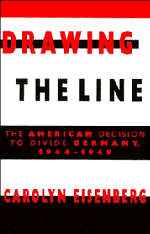Book contents
- Frontmatter
- Contents
- Preface and Acknowledgments
- Germany – Occupation Zones, 1945
- Introduction: Private Polowsky's Oath
- 1 Plans
- 2 Making Peace
- 3 The Limits of Reform: The U.S. Zone
- 4 A Fragile Friendship
- 5 The Russian Challenge
- 6 Bizonal Beginnings
- 7 The Doctors Deliberate
- 8 Marshall's Medicine
- 9 A Separate State
- 10 Cold War Germany
- 11 Winning
- Conclusion: The American Decision to Divide Germany
- Bibliography
- Index
3 - The Limits of Reform: The U.S. Zone
Published online by Cambridge University Press: 07 October 2009
- Frontmatter
- Contents
- Preface and Acknowledgments
- Germany – Occupation Zones, 1945
- Introduction: Private Polowsky's Oath
- 1 Plans
- 2 Making Peace
- 3 The Limits of Reform: The U.S. Zone
- 4 A Fragile Friendship
- 5 The Russian Challenge
- 6 Bizonal Beginnings
- 7 The Doctors Deliberate
- 8 Marshall's Medicine
- 9 A Separate State
- 10 Cold War Germany
- 11 Winning
- Conclusion: The American Decision to Divide Germany
- Bibliography
- Index
Summary
At every level of Military Government and from one end of the Zone to the other, we encountered the arguments of expediency and convenience, the necessity of “keeping things running,” the dangers of “angering” the Germans and creating a dissatisfied “bloc” which would be ripe for communism, the resentment of lower headquarters against interference from higher headquarters, the fantastic comparison of Nazi politics with Democratic-Republican rivalry in the USA.
(Russell Nixon, Acting Director of the Division of Cartels and External Assets to the Kilgore Committee).Hitler did restore their self-respect when all men's faces were turned from them. He did stop unemployment. He did give the young people something to live for and something they thought it worthwhile to sacrifice themselves for. And we should not forget that he played on the fear of Bolshevism which loomed a few miles away across Poland. Our views may have been modified in the last few years, but it is fair to ask how many of us can throw stones at people who feared Communism.
(Laird Bell, Deputy Director, Economics Division, Speech to the Chicago Council of Foreign Relations).Under the Potsdam Accord, the Americans committed themselves to substantial structural change and redistribution of power within German society. Yet during their own planning process, they had been unable to agree on the character of postwar Germany.
Since the Allied victory in May 1945, their longstanding philosophical differences had become focused on several practical issues of occupation: I) what steps should U.S. Military Government take to eradicate Nazism as a significant force in its own zone? 2) what approach should it adopt in treating the large German cartels and combines?
- Type
- Chapter
- Information
- Drawing the LineThe American Decision to Divide Germany, 1944–1949, pp. 121 - 165Publisher: Cambridge University PressPrint publication year: 1996



